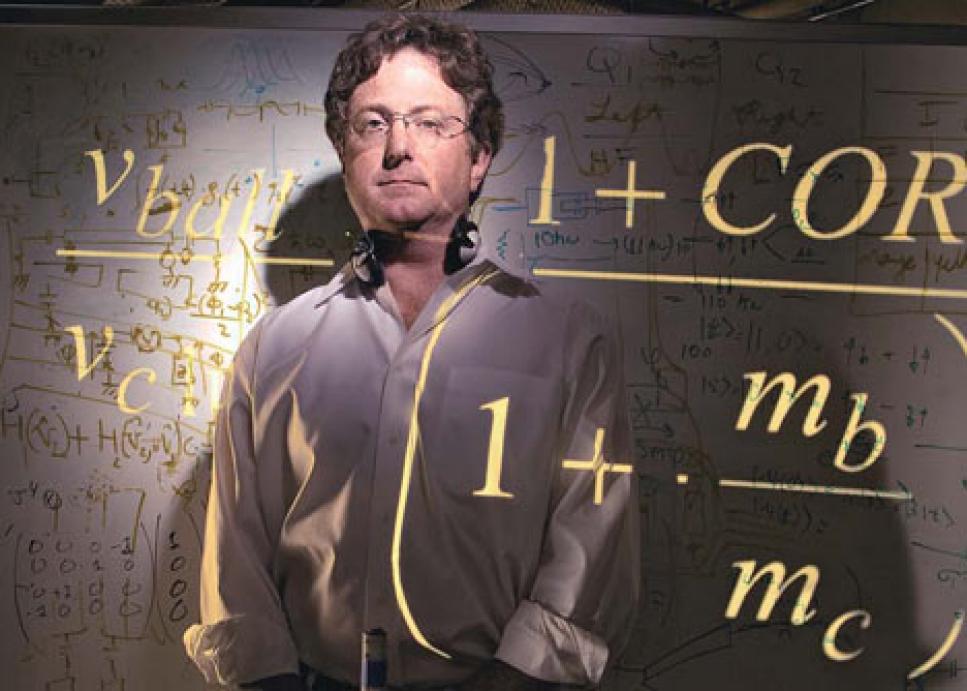Equipment
Golf tech: Breaking the sound barrier

Bob Grober and his singing club have made the golf swing audible.
You can see a good swing and you can feel it, but except for the unmistakable sound of a club striking the ball squarely, no one has entertained the possibility of hearing it. This hidden frontier of learning, the missing piece of golf's sensory puzzle, might finally have been found thanks to Bob Grober, a professor of applied physics at Yale University. A 1-handicapper, Grober, 44, has invented an auditory device he says can reveal immediately whether you are swinging the club with all the speed, power and efficiency you possess.
Grober's device is one of a kind, and upon using it, it's hard to dispute his enthusiastic claim. A small, wireless transmitter inserted into the butt end of the club detects the club's movement, and the signal is transmitted to an iPod-size unit attached to the player's waist. The auditory signal is relayed to a set of lightweight headphones, and the sound manifests in real time as a pleasing, organ-like tone when the player swings. If your clubhead is decelerating through impact, or your change from backswing to downswing is too quick, or your mechanics are dreadfully out of sync, the device will tell you. How? The faster the club is traveling, the louder the volume and higher the pitch. The idea is to make the device emit the loudest sound at impact, not before. This alone is not news, but emphatic, instantaneous feedback of the dreaded "decel" has never been available. The unit not only registers how fast the club is moving on the downswing, it also gives a start-to-finish speed profile.
"Sight and feel are important senses, but if the teacher or student, or both, aren't particularly skilled in those areas, it hinders the application of the mechanics you're striving for," says Grober. "I think it's the biggest reason teachers and players work so hard and don't always get significantly better."
Grober, who says his brain has been wired for physics from the time he tore apart his clarinet and put it back together as a child, thinks sound will become an indispensable tool. He even founded a company, Sonic Golf, to support his invention. He notes there are three distinct tendencies among golfers at different skill levels. Golfers with handicaps of 20 and above are cursed with lousy rhythm. "They're like poor dancers," he says. "You can demonstrate what good rhythm is, but like Steve Martin's Navin Johnson character in 'The Jerk,' they have a terrible time emulating it. The sound they obtain is abrupt, and clearly loudest at the wrong moments as opposed to increasing gradually."
Intermediate golfers, who include players with handicaps as low as 5, are prone to expending their speed too early. "They often generate very nice speed, but the loudest moment comes just before impact," Grober says. "These are players who have terrific days when for whatever reason they're generating maximum speed at the ball. They also have horrific days when they err the other way."
Then there are tour players, whose tendency, according to tour veteran and Sonic Golf fan Grant Waite, is rushing down from the top, albeit to a lesser degree than amateurs. "There should be a brief period when the club is scarcely moving at all while the lower body begins to clear out," says Waite. "We tend to hurry the change of direction, and it's helpful to find that out by measuring what the club is doing, as opposed to just using your body as the frame of reference."
The unit will be available in October, and Grober is figuring on a price of about $350. A demonstration can be viewed at sonicgolf.com. "I've always held that every field can be improved by the application of science," he says. "A little art can help that along, and being able to put the concept out there publicly is music to my ears."

TECH
LIGHTING THE WAY
Want to know exactly where you're aiming on putts? The face-balanced RedEye i330 Laser Putter comes with a plastic, half-circle target that beeps when you aim dead center, so it works even in bright sun. With a few simple screws, the putter's laser cartridge can be replaced with a regular face insert of identical weight to make the club legal for tournament play. The only drawback: A squarely addressed golf ball blocks the beam ($180, redeyegolf.com).